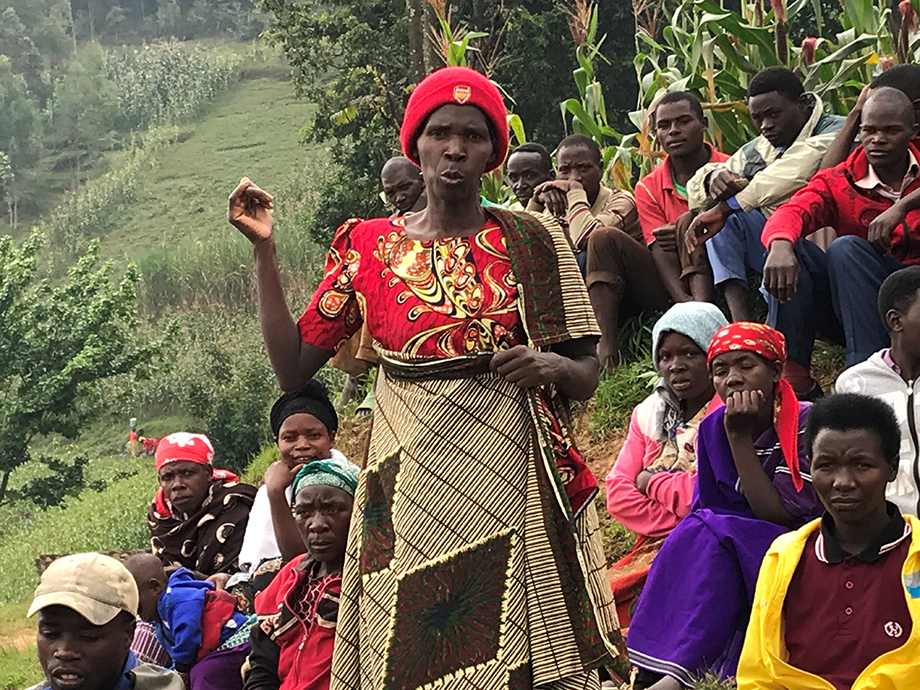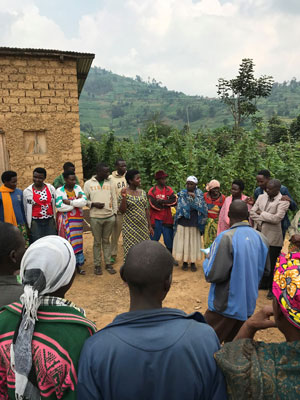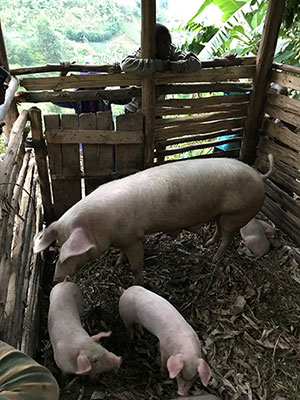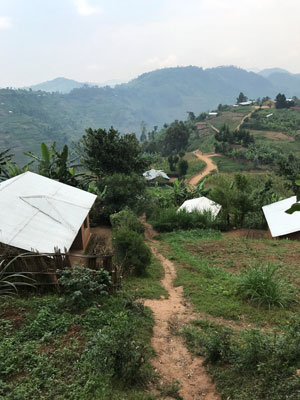Communities
Location: Rwanda
Gashishi’s community goals:
- Improve crops through better farming techniques, funding education for every child and health insurance for every family.
Akamiyove’s community goals:
- Improve the harvest using manure from pig-rearing
- Provide every household with a new hoe
Siganiro’s community goals:
- Improved roofing for every home
- Acquire a cow for every family
- Acquire solar panels for every household
Community Context
Rwanda is mainland Africa’s most densely populated nation. However, with the exception of Kigali, Rwanda’s capital, the nation’s citizens crowd the countryside rather than cities. According to the World Bank, 82 percent of Rwandans live in rural areas, which consist almost entirely of small villages tucked into rippling hills, punctuated by volcanic mountains along the country’s northern border. Approximately 75 percent of the nation’s land is under cultivation.
Although the economy has steadily climbed back from the devastating 1994 genocide (which claimed between 500,000 to 1 million lives), as of 2015, 39 percent of the population lived below the poverty line, according to government statistics. One such Rwandan was Nyirankunzurwanda Marie Chantale.
As Bridgespan reported in this Stanford Social Innovation Review article, seven years ago, Marie Chantale could barely provide a single daily meal for her husband and six children. Sometimes, she had to turn to her neighbors in the village of Siganiro, nestled just below steep ridgetops in northern Rwanda, to help feed her family. Like many of the village’s 74 households, Marie Chantale’s family lived in a one room house with a clay tile roof, which often leaked during frequent mountain storms. “The wind moved the tiles and the rain came through,” she recalled. “Our children got sick from the cold.”

However, in 2013, Marie Chantale and her neighbors pulled together to figure out how to collectively improve their lives. Significantly, Siganiro developed homegrown solutions to its challenges without depending on an outside aid organization to push solutions.
Peer-Driven Change: Origins & Evolution
Nevertheless, an outside organization did play a supportive role as Siganiro led its own revival. In 2010, an intermediary NGO, Spark MicroGrants, began working in Rwanda, with the aim of facilitating communities’ collective efforts to set their own goals for improving their lives and to control the process for achieving those goals. Spark eschews predesigned programs and it avoids dictating solutions. Instead, the NGO, in partnership with the Government of Rwanda, abets communities as they lead their own efforts to build a better future.
The logic for this approach grew out of the experience of Spark’s co-founder and CEO, Sasha Fisher. She had previously spent time in South Sudan, helping an outside aid organization build schools for girls. However, even though more than 70 percent of the region’s children cannot access an education, the school buildings were rarely used, largely because “the outsiders didn’t engage the South Sudanese…so when the outsiders left, nobody was there to run the projects,” Fisher explained.
With the lesson from South Sudan still fresh, Fisher and colleagues launched Spark MicroGrants, which reverses the top-down, prescriptive approach that many aid programs take. Instead, Spark and the Government of Rwanda train local young people[1] to facilitate community-wide meetings, guiding peers as they collectively envision a common goal (such as “generate income”) as well as a pathway for achieving it (“launch a motorcycle taxi business”).[2]
As the community works toward its vision of success, Spark contributes a total of $8,000 in seed funding over three years,[3] to support families as they bring the project to life. Peers also establish a community-wide savings group, to help fuel the project. In this way, Rwandan families tap into one of peer-driven change’s fundamental features, financial capital, where they share funding from internal sources (such as savings groups), as well as from external sources, such as funders and nonprofits.
Additionally, peers—not Spark—establish the community’s overall goal, define and execute the project, and own the result. This combination of freedom, control, and accountability is crucial. Peers have sufficient space to opt into a project of their own choosing and they oversee its execution. They thereby harness another core feature of peer-driven change— self-determination and initiative—which just might increase the odds that the project will succeed. “If people are able to choose the project, they will feel ownership and sustain it,” said Innocent Impano, a Spark senior facilitator trainer.
The third feature of peer-driven change—mutuality—exists within all peer groups. Human experience abounds with examples of neighbors helping neighbors. However, mutuality might appear to be latent in some Rwandan communities. Working with the Rwandan government, Spark identifies communities where leadership and social cohesion are not as strong as they could be and where there is the most room for socioeconomic improvement.[4]
Peer-Driven Change’s Inner Workings

Over the course of three days, a Bridgespan research team visited three northern Rwandan villages that are leading their own change, with support from Spark and the government: Gashishi, Akamiyove, and the aforementioned Siganiro. The average annual income for families in these villages is USD 160, although some families make as little as USD 53.
Gashishi
Gashishi is home to 146 households, whose main source of income is from farming beans and maize. The village’s location in the high mountains puts its soil at risk of erosion from rainfall runoff and makes it challenging to access basic services. The nearest market is 20 kilometers up a rutted, serpentine road; there are just two natural water sources within the entire village.
On the day the research team visited, Gashishi was in the midst of a four-to-six month planning phase, where the community collectively identifies a goal and a pathway, or project, to achieve it. Two young facilitators, male and female, stood before a large sheet of flip-chart paper taped to the side of a dwelling. Several dozen adults sat before them. To clarify the difference between a goal and a pathway, the female facilitator drew a picture of a bus driving up the twisty mountain road to the market, with various stops along the way. She explained that the road was the pathway they would take to arrive at their final destination—their over-arching goal—and the stops were the various projects they could take on. This gave people a mind map of the journey they were about to undertake.

The villagers then divided into four separate groups, where they brainstormed ideas for a shared, community-wide goal. The conversations were lively, with women speaking as often as the men.[5] When everyone regrouped, they surfaced four goals for further discussion: improve the crops; increase the harvest; ensure that all the village’s children can access school; ensure that each household has the funds to pay for health insurance.
Because the community collectively brainstormed around the four options, they avoided an up-or-down vote, which might have alienated the “losing” side. Instead, they worked toward a consensus: increase the harvest. Their reasoning was based on sequencing. Improving the crops through better farming techniques (such as by sourcing more fertilizer with Spark’s funding) would yield more maize and beans. When combined with some funding from the community-wide savings group, the total harvest could potentially generate enough revenue for every child to attend school and every family to acquire health insurance.
Having arrived at a common goal, the community would continue meeting over the ensuing weeks to map out next steps, including: identify a project that would help them increase the harvest; create an operational plan; complete a risk assessment; and develop metrics to measure success. Gashishi had both the freedom to make its own choices and the control to lead its own change.
Akamiyove
Akamiyove is a village that is similar in many ways to Gashishi. Yet the 95 households in the community came up with a very different goal, one that was more meaningful to their particular circumstances.
Akamiyove was in its post-implementation phase, where the community meets four times over the course of a year to review its progress and map out its transition from Spark, when peers would launch their own, independent effort to collectively identify their next goal and project. When the research team visited, the community was in the midst of reviewing the results of its pig-rearing project, whose goal was to provide manure to improve the harvest and also generate enough income to provide every household with a new, indispensable hoe.

With a portion of its Spark funding plus funds from its pooled savings, the community purchased 10 pigs, which had thus far delivered 42 piglets. However, the project had run into an array of challenges, which the facilitators captured on a sheet of flip-chart paper. They then guided the community through an effort to come up with a mitigation plan for each of the challenges.
For example, the price of feed had jumped, making it increasingly difficult for some community members to cover the cost of caring for their pig. To mitigate, the community agreed to pull some of the money that remained in Akamiyove’s Spark grant. Thieves had also stolen two pigs and dogs had killed several others, an acute loss. After discussion, it was agreed that each family that received a pig was responsible for securing it. In this way, the community harnessed something that was beginning to surface: mutuality. Instead of depending on professionals to crack a problem, peers collectively worked out their own mitigation strategies. That is not to suggest the process went smoothly. People disagreed and sometimes talked over each other, which sometimes happens as community members grapple with a project’s challenges.
Working through those challenges together strengthened their social ties. Ntawnzera Frederic, who received one of the community’s first pigs, conceded that caring for the animal was costly and sometimes complicated. But along with a subgroup of peers, he started a savings group to help pay for the pig’s feed. He expects the animal’s manure will help increase the subgroup’s bean harvest by 40 percent. This example of mutuality—of neighbors pitching in and collectively improving their livelihoods—was somewhat of a new experience.
Residents of Akamiyove as well as the other two villages remarked that they and their neighbors used to pretty much fend for themselves. (As we’ve pointed out, the lack of social cohesion was one of the reasons why the Rwandan government and Spark MicroGrants selected these communities.) No doubt, mutuality resided deep within the communities. But it might well have been a sense of shared fate—the notion that “we’re all in this together”—and working collectively to achieve a shared goal that brought mutuality to the surface. Previously, according to Frederic, the village had never even held a community-wide meeting. “Now we come together to decide our future.”
Siganiro
Siganiro graduated from Spark’s program in 2016, but continues to apply what it had learned in pursuing its own projects, independent of Spark. On the day the research team visited, the community had gathered to review its project outcomes and begin thinking about next steps.

The community’s first goal was to purchase iron sheets for every household, to replace the clay tile roofs that leaked during violent rainstorms. To attain that ambitious goal, the community used part of its Spark grant to purchase fertilizer to improve its bean harvest. Families also launched a village-wide savings group, to which each family contributed USD 1.10 monthly. Over the course of three years, with revenue from the harvest and additional monies from the savings group, the collective effort enabled every household to acquire a much improved roof, at a total cost of around USD 9,335.
In 2018, Siganiro collectively agreed on a new goal: acquire a cow for every family. Having learned that mutuality is a critical success factor, the community first elected a leadership team (30 percent of whom are women) and adopted regulations to promote cooperation (such as requiring people to attend community meetings). The community also agreed that once every month, a different family could withdraw USD 100 from the savings group, for down payment on a cow. Within a year, Siganiro was nearly halfway towards its goal.
Jean Bosco Ndikumana, who was first in the community to acquire a cow (because his number was drawn first in a lottery), reported that within three months, the animal produced a metric ton of manure. At that rate, the cow would deliver enough fertilizer to nearly triple his bean harvest.
Additionally, community members were taking the initiative to launch their own side businesses. With two separate loans from the savings group, Marie Chantale purchased chickens and began selling their eggs. With proceeds from the egg business and the improved bean harvest, she bought a small plot of land to expand the family’s bean crop. Her family was eating better, and she and her husband were earning enough to buy school uniforms and shoes for their children.
Another community member borrowed USD 15 from the savings group to expand his banana-tree plantings from 30 to 75. A third resident borrowed USD 50 to buy a ewe; she sells the sheep’s offspring to cover the cost of her children’s school fees, among other expenses. These are but three examples of what the social entrepreneur Mauricio Miller, who has championed the peer-driven change model in the social sector, observes in his 2017 book, The Alternative: “Getting ahead is truly a self-directed but group effort.”
Having accumulated sufficient trust, reciprocity, and cooperation across two ambitious projects, community members concluded the meeting by committing to their next outsize goal: acquire solar panels for every household, so Siganiro could finally have electricity.
Progress & Results
As we’ve seen, Siganiro accomplished its original goal of providing improved roofing for every home in the community and was well on its way to realizing its second goal: acquire a cow for every household. Despite the complications surrounding its pigrearing project, Akamiyove generated enough revenue to purchase a hoe for every household. And similar to Siganiro, residents took the initiative to launch their own side businesses. For example, Akamiyove’s Mwisemega Gugemie is solely responsible for providing for her eight children, a chronic struggle. However, she is optimistic that the manure from her adult pig will help increase her bean harvest by 30 percent. Gugemie will use some of the proceeds to launch her own side business, brewing and selling sorghum beer.
However, those outcomes, by themselves, fall short of capturing some of what matters most: the ways in which peer-driven change can potentially strengthen communities. That is why Spark MicroGrants also tracks, across the five African countries it works in,[6] civic engagement (where 59 percent of participating peers are women), inclusive leadership (44 percent of elected community leaders are women), and social cohesion (85 percent of communities continue to meet independently, post-Spark).
Could the communities have achieved those outcomes with just Spark’s seed funding? Is Spark’s facilitative process an essential component in igniting and sustaining peer-driven change, at least in communities that are experiencing deep poverty or the after-effects of war or other conflicts? Answering those questions will require additional research and testing.
However, there is solid evidence that Spark’s facilitative approach to supporting peerdriven change is scalable. “The Government of Rwanda,” says Sasha Fisher, “is working to apply the process to every village in the country, on an annual basis, and thereby make it a formative part of how villages organize, how families care for each other, and ultimately how they make progress against poverty.”
Key Insights
Capital incentivizes as well as enables. Spark’s $8,000 seed grant is delivered in three installments of 60 percent, 30 percent, and 10 percent. The first round of funding doesn’t simply get the project off the ground. It is a no-strings-attached commitment to the community, which incentivizes people to show up at meetings and begin to lead their own change. This is especially important in northern Rwanda, where at least two external aid organizations launched interventions that ultimately failed, leaving skeptical communities in their wake. Spark’s upfront funding signals that the community’s goals can come to life, so long as people pull together and collectively work towards them.
Transparency builds trust. Transparency is critical for communities as they implement projects. In Siganiro’s community meetings, people are expected to show receipts for deposits into the savings group, as well as receipts for purchases that were made with savings group loans. At these same meetings, all community members were notified when Spark deposited a portion of its grant into the community account. The logic for this approach: As transparency spreads, trust deepens. “I appreciate that people’s contributions [to the savings group] are collected in public,” said Siganiro’s Jean Bosco Ndikumana. “It increases accountability.”
Peer-driven progress is contagious. As Siganiro acquired an iron roof for every home in the village and made significant progress against its goal of providing a cow for every family, its success rippled to surrounding communities. Leaders of those villages visited Siganiro, to learn about how residents acquired funding and collectively designed solutions to their challenges. All of those villages subsequently engaged Spark. More broadly, 71 percent of the 325 African communities that have worked with Spark have gone on to launch their own standalone, peer-driven initiatives.
This case study was researched and written by Bridgespan partners Rohit Menezes and Willa Seldon, and Manager Simon Morfit, from the San Francisco office, along with Editorial Director Bill Breen, who works from Bridgespan’s Boston office. The authors thank former Bridgespan Consultant Rachel Heredia for her research and insights.
Notes:
[1] Spark and the Rwandan government specifically look for local, educated young people to become Community-Based Facilitators (CBFs). “[Such people] are the future of this country,” a government official explained, and the experience of guiding community-wide discussions and decision making prepares them to possibly step into leadership roles of their own.
[2] A government Social Economic Development Officer manages the CBFs, while Spark provides training and ongoing coaching. But the facilitators—not Spark—moderate meetings and guide the community as it leads its own change.
[3] Over the course of three years, Spark’s Facilitated Collective Action Process rolls out in three phases: planning, implementation, and post-implementation.
[4] Specifically, the government and Spark select communities that have low scores on key “social protection” indicators, including: high proportions (80%) of families that either do not own a house and can hardly afford basic needs, or they own a dwelling but lack access to a full-time job; high levels of malnutrition; low levels of Mutuelle (health insurance) payment and SACCO (credit union) membership.
[5] Although Rwanda has made significant strides towards gender equality, ranking sixth on the World Exonomic Forum’s Global Gender Gap Index (highest in Africa), Rwandans such as Donatille Mukabalisa, the country’s parliamentary speaker, insist they “still live in a patriarchal system.” In the three community meetings that the Bridgespan team witnessed, women were equally represented.
[6] In addition to Rwanda, Spark is also active in Uganda and Burundi, and has limited partnerships in the Democratic Republic of Congo and Ghana.

